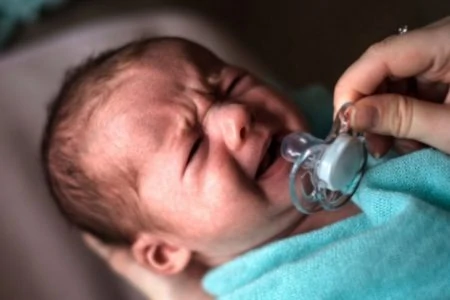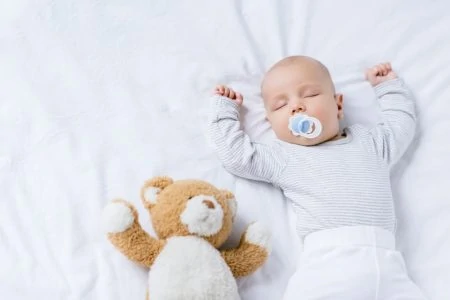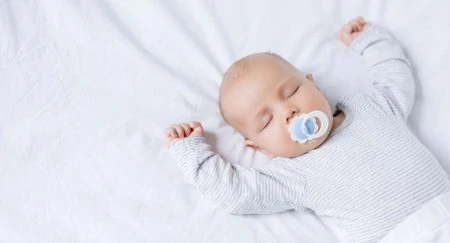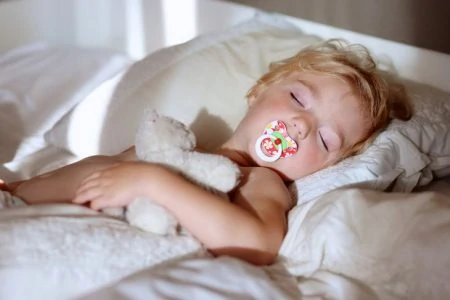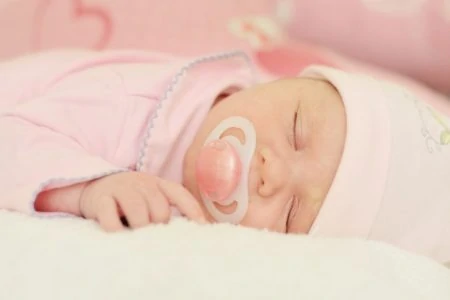Are you wondering if your baby is safe while using a pacifier?
Modern parenting involves questioning almost everything. We know some old-school medicines are unsafe and crib bumpers are risky, so we naturally cast a suspicious eye toward other common items.
Pacifiers are not exactly black and white.
We studied the modern research on pacifier usage to uncover the advantages and disadvantages. This comprehensive safety guide will help you make an informed decision about whether a binky is right for your child.
Key Takeaways
- Watch the teeth: Extended pacifier use can impact the alignment of your baby’s teeth and the shape of their palate.
- Check for safety: Always buy from established brands and inspect the shield for ventilation holes and loose parts.
- Wean on time: Experts recommend weaning your baby off the pacifier between 6 and 12 months to avoid ear infections and dependency.
- Avoid DIY clips: Never use a homemade tie or strap around a baby’s neck as it poses a serious strangulation hazard.
- Pacifiers Can Impact Dental Development
- Inspect Pacifiers to Prevent Choking Risks
- Early Use May Affect Breastfeeding Habits
- Germs Can Linger on Dirty Pacifiers
- Pacifiers Offer Sleep Safety Benefits
- Specific Situations Warrant Pacifier Use
- Establish a Timeline for Pacifier Use
- Pacifier Safety FAQs
- The Bottom Line
Pacifiers Can Impact Dental Development
Pacifiers are not great for teeth. Experts agree on this, and it remains the biggest concern for parents. Despite the risks, statistics suggest over 80% of babies use them (1).
Extended use gently nudges your baby’s teeth into new positions because of the nipple shape. It acts a bit like orthodontic braces. Moderate evidence shows pacifiers can cause upper teeth to splay outward and lower teeth to tip inward (2). They may also alter the shape of the roof of the mouth.
Tooth-friendly bottles exist, but pacifiers sit in the mouth for much longer periods. This creates constant pressure that impacts alignment.
Even naturally shaped pacifiers have an effect. Buck teeth or severe overbites are not just cosmetic issues; they can delay speech, cause swallowing difficulties, create problems with eating solids, and hinder jaw development.
These problems rarely occur when a baby has no teeth or only a few. However, you should wean your baby off the pacifier well before they develop a full set of baby teeth to avoid permanent damage.
Inspect Pacifiers to Prevent Choking Risks
Anything that goes into a baby’s mouth poses a choking risk. We cannot automatically trust that a product is safe just because it is sold in stores.
Stick to established manufacturers. Cheap novelty items or outdated designs often have loose parts that become dangerous. Check the U.S. government’s website for recalls before purchasing to ensure your chosen brand is safe.
Verify the pacifier size, construction, and ventilation before use:
- Size matters: Your baby’s age determines the correct size. Always choose an age-appropriate model unless a medical condition like prematurity requires a smaller fit. A safe pacifier shield must be at least 1.5 inches wide (3) so the baby cannot fit the entire object into their mouth.
- One-piece construction: Buy a pacifier made of a single solid piece of silicone. If the shield and nipple are separate parts, throw it out. Inspect the nipple before every use for cracks or weakness.
- Proper ventilation: Federal regulations require pacifiers to have at least two large air vents in the shield. These holes allow a baby to breathe if the pacifier accidentally gets sucked entirely into the mouth (4).
Perform the “pull test” regularly to ensure the nipple is secure.
Finally, never use a DIY tie or long ribbon. These can wrap around a baby’s neck and cause strangulation. Only use safety-tested clips with short leashes.
Early Use May Affect Breastfeeding Habits
Pacifiers can cause nipple confusion if introduced too early. A newborn might reject the breast or bottle because the artificial nipple feels different from a natural one.
Pacifiers can affect how a newborn latches during those crucial first weeks. The latch on a pacifier is generally shallower. This muscle memory can make it difficult for the baby to take in enough breast tissue for a deep, effective feed later.
Brands like Hevea and NUK try to imitate the shape and movement of a mother’s nipple. These may help your baby suck in a more natural way.
Pacifiers create other feeding challenges. They satisfy the sucking urge, which means a small baby might not signal hunger as quickly. This can lead to fewer feeds and subsequently lower milk supply for the mother.
Pro Tip
However, some babies treat the breast like a pacifier. If your baby sucks without swallowing long after the feed ends, you might get sore. In this case, using a pacifier for short periods can give you a break and prevent cracked nipples.
Germs Can Linger on Dirty Pacifiers
Pacifiers carry bacteria and yeast, which places babies at risk for infections. The object touches various surfaces and then goes into the mouth, allowing organisms to hitch a ride.
Microbes breed in the tiny pores of the material. Unless you keep a fresh supply and sterilize pacifiers regularly, they will harbor germs (5). Wash them frequently with hot, soapy water and let them air dry. Never lick them clean yourself or share them between siblings. Replace them every four to eight weeks.
Recent studies link pacifier use to ear infections in babies between six months and two years old.
The exact cause is debated. Experts believe sucking changes the pressure in the ears, which creates an environment where infections thrive. Others suggest that pacifiers are simply more common in babies who are not breastfed, and formula-fed babies already have a slightly higher risk for ear infections (6).
The American Academy of Pediatrics (AAP) and Family Physicians recommend weaning the pacifier around 6 to 12 months to help prevent these issues.
Pacifiers Offer Sleep Safety Benefits
Pacifiers are a lifesaver for parents of restless sleepers. The sucking action helps babies settle down, which prevents you from becoming a human pacifier all night long.
Crucially, pacifiers reduce the risk of SIDS (Sudden Infant Death Syndrome). The specific reason is unknown, but researchers assume the sucking motion keeps the baby’s breathing rate regular and prevents them from falling into a sleep that is too deep to wake from.
The downside is the potential for sleep associations. This is essentially a habit. Your baby might become unable to fall asleep without the plug. You may find yourself waking up repeatedly to pop it back in their mouth.
Experts suggest weaning between 6 and 12 months to avoid this dependency while still gaining the SIDS protection benefits during the most vulnerable period.
Specific Situations Warrant Pacifier Use
Certain scenarios exist where a pacifier provides significant help to babies (7). Non-Nutritive Sucking (NNS) offers medical and emotional benefits in specific contexts:
- Pain management: Offering a pacifier during painful procedures, like circumcision, heel pricks, or shots, comforts the baby. It helps their heart rate return to normal faster. Dipping the pacifier in a little sugar water or breast milk enhances this pain-relief effect.
- Separation anxiety: A pacifier helps when babies must be separated from their mothers, such as during a hospital stay. It allows the infant to self-soothe and maintain their sucking reflex when they cannot feed directly.
- Premature development: Preemies in the NICU often need help learning to coordinate sucking, swallowing, and breathing. NNS allows them to practice this pattern safely before transitioning to full oral feeding.
Establish a Timeline for Pacifier Use
Timing is everything. A healthy breastfed baby should only start using a pacifier once nursing is well established to avoid nipple confusion. Bottle-fed babies can usually start once they regain their birth weight (8).
Crucial To Know
Some babies wean themselves. They might start chewing on the shield when they begin teething. Seize this moment. Swap the binky for a teething toy to make the transition easier. Remove all pacifiers from the house immediately so you are not tempted to give them back during a fussy moment.
Pacifier Safety FAQs
The Bottom Line
Pacifiers come with distinct pros and cons. You are the only one who can decide if they fit your parenting style.
Timing is the most important factor. Starting too soon can hinder breastfeeding, while stopping too late can cause dental issues. Frequency matters too; constant sucking may increase the risk of ear infections and delay speech development.
Consider using the pacifier strategically. It is excellent for pain relief and SIDS prevention during sleep in the first year. Beyond that, the benefits decrease while the risks rise.
Use this guide to make your choice. If you decide to use one, wean at the appropriate age and avoid using it as a constant crutch. This approach ensures your baby stays happy, healthy, and safe.
